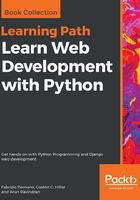
Byte arrays
To conclude our overview of mutable sequence types, let's spend a couple of minutes on the bytearray type. Basically, they represent the mutable version of bytes objects. They expose most of the usual methods of mutable sequences as well as most of the methods of the bytes type. Items are integers in the range [0, 256).
[a,k1)+[k1,k2)+[k2,k3)+...+[kN-1,b)
The middle points ( ki) being excluded on one end, and included on the other end, allow for easy concatenation and splitting when intervals are handled in the code.
Let's see a quick example with the bytearray type:
>>> bytearray() # empty bytearray object
bytearray(b'')
>>> bytearray(10) # zero-filled instance with given length
bytearray(b'\x00\x00\x00\x00\x00\x00\x00\x00\x00\x00')
>>> bytearray(range(5)) # bytearray from iterable of integers
bytearray(b'\x00\x01\x02\x03\x04')
>>> name = bytearray(b'Lina') #A - bytearray from bytes
>>> name.replace(b'L', b'l')
bytearray(b'lina')
>>> name.endswith(b'na')
True
>>> name.upper()
bytearray(b'LINA')
>>> name.count(b'L')
1
As you can see in the preceding code, there are a few ways to create a bytearray object. They can be useful in many situations; for example, when receiving data through a socket, they eliminate the need to concatenate data while polling, hence they can prove to be very handy. On the line #A, I created a bytearray named as name from the bytes literal b'Lina' to show you how the bytearray object exposes methods from both sequences and strings, which is extremely handy. If you think about it, they can be considered as mutable strings.